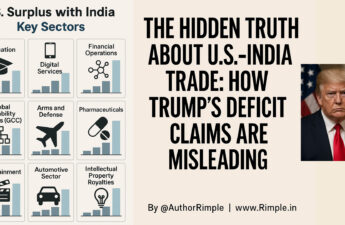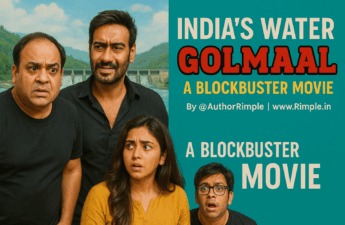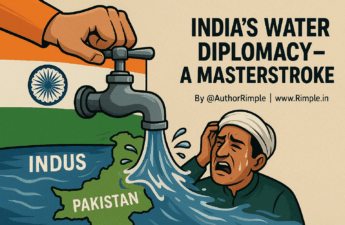In the complex chessboard of global politics, nations often smile on the surface while plotting behind closed doors. Today, India stands at a critical juncture, its rise as a global power undeniable. Yet, this very ascent has made it a target for those who fear its potential. From the United States to Pakistan, from internal traitors to global powers, a sinister conspiracy is unfolding—one aimed at dragging India into a war, sparking civil unrest, and crushing its dreams of becoming a superpower. At the heart of this battle is Prime Minister Narendra Modi, a leader whose foresight and restraint are India’s greatest assets. Let’s connect the dots, uncover the truth, and rally behind Modi, Sanatan Dharma, and the unity of our nation.
Chapter 1: The Storm Brewing Before the Pahalgam Attack
To understand the trap being set for India, we must first examine a series of events that unfolded in early 2025, carefully orchestrated to provoke and destabilize our nation. These are not random incidents but pieces of a larger puzzle.
U.S. Aid to Pakistan (February 28, 2025)
Just two months before the devastating Pahalgam attack, the U.S. Trump administration approved $397 million in security aid to Pakistan, officially to maintain its F-16 fighter jets for counter-terrorism operations. But why this sudden generosity? Pakistan has a history of misusing such funds, often funneling them to terrorist groups targeting India. Indian intelligence has flagged concerns that this aid may have indirectly fueled the Pahalgam attack, designed to provoke India into war. The U.S., while publicly supporting India, seems to be playing a double game—arming Pakistan while watching India’s response.
Pakistani PM and Army Chief’s Visit to Saudi Arabia (March 19–22, 2025)
Less than a month before the attack, Pakistani Prime Minister Shehbaz Sharif and Army Chief General Asim Munir made a high-profile joint visit to Saudi Arabia, accompanied by key ministers. This was no ordinary trip. The urgency of both leaders traveling together suggests a deeper agenda. Officially, the visit aimed to strengthen economic and security ties, with discussions on trade, investment, and regional stability. But Saudi Arabia, a long-time ally of Pakistan, has also been a hub for anti-India narratives, especially concerning Kashmir. Was this visit a cover to secure funding or logistical support for terrorist activities? The timing—right before a major attack—raises serious questions.
Hamas and Pakistani Terrorists Meet in PoK (February 5, 2025)
A month before the attack, a chilling gathering took place in Pakistan-occupied Kashmir (PoK). Senior Hamas leaders, including spokespersons Khalid Qaddoumi and Naji Zaheer, met with top terrorists from Jaish-e-Mohammed (JeM) and Lashkar-e-Taiba (LeT) at a rally in Rawalakote, titled “Kashmir Solidarity and Hamas Operation Al Aqsa Flood.” Nearly 100 foreign militants attended, signaling a dangerous alliance. This was the first known instance of Hamas openly participating in PoK, aiming to link Pakistan’s jihad in Kashmir with Hamas’s fight against Israel. Indian intelligence reports suggest they were planning to escalate violence in Jammu and Kashmir, targeting civilians to provoke communal tensions. Why now? To destabilize India at a time when it’s gaining global influence.
Pakistani Army Chief’s Anti-India Tirade (April 17, 2025)
Just five days before the Pahalgam attack, General Asim Munir delivered a provocative speech in Islamabad, calling Kashmir Pakistan’s “jugular vein” and declaring, “We are different from Hindus in every possible way.” His words were not just anti-India but specifically anti-Hindu and anti-Modi, framing India’s leadership as an enemy of Pakistan’s existence. This inflammatory rhetoric was no coincidence—it was meant to incite hatred and set the stage for the attack, pushing India toward an emotional retaliation.
Chapter 2: The Pahalgam Attack and Its Sinister Motives
On April 22, 2025, tragedy struck Jammu and Kashmir’s Pahalgam, where 26 civilians, Hindu tourists, were brutally killed in a terrorist attack—the deadliest on civilians in two decades. This was no ordinary act of terror; it was a calculated move to ignite chaos in India. Let’s break it down:
Targeting Hindus to Spark Civil War
Unlike previous attacks that often targeted security forces, this one deliberately focused on ordinary Hindu civilians. The terrorists openly declared, “Tell your Modi that we’re killing Hindus deliberately.” Why Modi? Because he is not just India’s Prime Minister but a global symbol of Sanatan Dharma, revered by millions of Hindus. By targeting Hindus and taunting Modi, the attackers aimed to inflame Hindu-Muslim tensions, pushing India toward communal riots and civil war. A divided India would be weak, its global rise halted.
Suspicious Timing: Global Leaders and Modi’s Absence
The attack’s timing was uncanny. It occurred while U.S. Vice President JD Vance was visiting India, exploring cultural sites like Jaipur’s Amber Fort. Simultaneously, PM Modi was in Saudi Arabia, engaging in diplomatic talks. This suggests the attack was planned to embarrass India on the global stage, portraying it as unstable while its leader was abroad. The presence of a U.S. leader added pressure on India to respond aggressively, potentially escalating tensions.
The Bangkok-Based Leader’s U.S. Visit
A week earlier, a young Indian leader based in Bangkok visited the U.S. While the exact purpose remains unclear, such visits often involve lobbying or aligning with foreign agendas. Was he acting on someone’s orders to push an anti-India narrative? His future speeches and actions will reveal more, but this visit hints at external forces trying to influence India’s internal politics.
Global Powers’ Double Game
In the attack’s aftermath, the U.S., Canada, Germany, France, and the U.K. issued statements saying, “India is free to act however it likes.” On the surface, this seems supportive. But in reality, it’s a trap. These nations, while publicly backing India, want it to launch a war against Pakistan. Why? A war would drain India’s resources, derail its economic growth, and prevent it from challenging superpowers like the U.S. and China. They’re essentially saying, “Go ahead, fight, and destroy yourself.”
Internal Political Traps
Within India, opposition parties that once questioned the Balakot airstrike’s evidence now claim to support Modi’s actions. Their sudden unity is suspicious. Are they hoping Modi starts a war, only to later criticize him if it backfires? Their goal may be to weaken Modi’s leadership, portraying him as reckless, and regain political power. This internal betrayal is as dangerous as external threats.
Pakistan’s War Threat
Pakistan has warned that if India blocks water under the Indus Waters Treaty, it will consider it an act of war. This is a deliberate provocation, daring India to make the first move. Pakistan, backed by its allies, is ready to escalate, knowing a war would weaken India more than itself.
Chapter 3: The Bigger Picture—A Global Conspiracy Against India
Let’s step back and see the forest for the trees. India’s rise as a global power threatens the established order. The U.S. fears China’s dominance but also sees India as a future rival. China, while pretending to support India, benefits from its instability. The U.S.-China tariff wars have boosted India’s economy, making it a manufacturing hub. This success has made India a target for those who want to trap it in conflict.
The Pahalgam attack, the PoK meeting, and Pakistan’s provocations are part of a broader conspiracy to:
Provoke Hindu-Muslim Riots: By targeting Hindus, the attackers want to spark communal violence, echoing past unrest like the farmer protests, CAA agitations, and Shaheen Bagh.
Force India into War: A war with Pakistan would exhaust India’s resources, halting its progress and pleasing global powers who fear its rise.
Undermine Modi and Sanatan Dharma: Modi’s leadership and Hindu identity make him a target. Weakening him weakens India’s unity and cultural pride.
Late General Bipin Rawat, India’s first Chief of Defence Staff, warned of a “half front”—traitors within India who support foreign conspiracies. These forces fuel protests, spread divisive narratives, and weaken the nation from within. The Indian Army can fight external enemies like Pakistan, Bangladesh, or China, but a civil war would leave it helpless. This is the ultimate goal of India’s enemies—to break it from within.
Chapter 4: Why Modi’s Restraint Is India’s Strength
PM Modi has shown remarkable wisdom in navigating this trap. Despite provocations, he has not declared war impulsively. His diplomatic moves—suspending the Indus Waters Treaty and shutting the Attari border—send a strong message without escalating to full-scale conflict. Modi understands that war would play into the hands of India’s enemies, both foreign and domestic.
Modi’s vision is clear: keep India united, focus on economic growth, and strengthen its global standing. He knows that emotional retaliation would lead to chaos, while strategic restraint keeps India on the path to greatness. His leadership is a beacon for Sanatan Dharma, promoting unity and resilience in the face of conspiracies.
Conclusion: A Call to Action for Every Indian
Friends, the conspiracy against India, Modi, and Sanatan Dharma is real. From U.S. aid to Pakistan to the Pahalgam attack, every move is designed to trap India in war and civil unrest. If this plot succeeds, India’s progress will be pushed back a century, plunging us into chaos.
But we, the people, can stop this. Here’s what we must do:
- Support Modi’s Leadership: Trust his judgment. Give him the freedom to act strategically, whether by stopping water or taking other measures.
- Reject Divisive Propaganda: Don’t fall for media or opposition narratives that fuel Hindu-Muslim fight. Stay united as Indians. Even if you want to oppose Muslims, don’t fuel the civil war situations as this is what all foreign countries want. Don’t let them succeed. Hope State governments take actions against Muslims to do anything. All Hindus, Jains, Sikhs, Parsis, Buddhist, stand together as Indians here.
- Expose the Traitors: Call out those who support foreign conspiracies, whether through protests or divisive rhetoric.
- Spread Awareness: Share this truth with every Indian. Let the world know we stand with Modi and Sanatan Dharma.
India’s enemies want us to fight among ourselves, but we are stronger together. Let’s rally behind PM Modi, protect our unity, and ensure India rises as a global superpower. As our scriptures say, “Satyameva Jayate”—truth always prevails. Let’s make it so.





